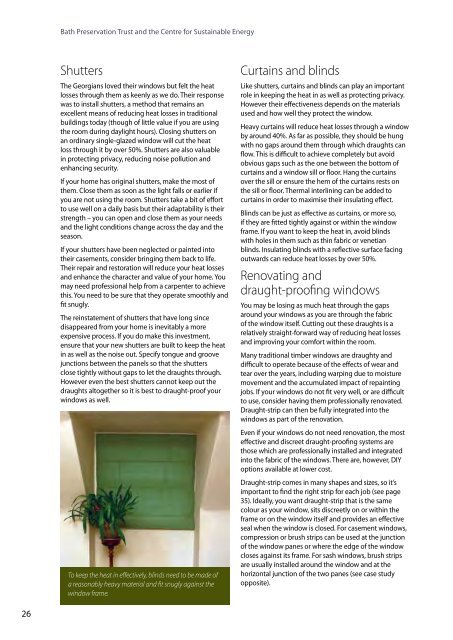Warmer Bath
You also want an ePaper? Increase the reach of your titles
YUMPU automatically turns print PDFs into web optimized ePapers that Google loves.
<strong>Bath</strong> Preservation Trust and the Centre for Sustainable Energy<br />
Shutters<br />
The Georgians loved their windows but felt the heat<br />
losses through them as keenly as we do. Their response<br />
was to install shutters, a method that remains an<br />
excellent means of reducing heat losses in traditional<br />
buildings today (though of little value if you are using<br />
the room during daylight hours). Closing shutters on<br />
an ordinary single-glazed window will cut the heat<br />
loss through it by over 50%. Shutters are also valuable<br />
in protecting privacy, reducing noise pollution and<br />
enhancing security.<br />
If your home has original shutters, make the most of<br />
them. Close them as soon as the light falls or earlier if<br />
you are not using the room. Shutters take a bit of effort<br />
to use well on a daily basis but their adaptability is their<br />
strength – you can open and close them as your needs<br />
and the light conditions change across the day and the<br />
season.<br />
If your shutters have been neglected or painted into<br />
their casements, consider bringing them back to life.<br />
Their repair and restoration will reduce your heat losses<br />
and enhance the character and value of your home. You<br />
may need professional help from a carpenter to achieve<br />
this. You need to be sure that they operate smoothly and<br />
fit snugly.<br />
The reinstatement of shutters that have long since<br />
disappeared from your home is inevitably a more<br />
expensive process. If you do make this investment,<br />
ensure that your new shutters are built to keep the heat<br />
in as well as the noise out. Specify tongue and groove<br />
junctions between the panels so that the shutters<br />
close tightly without gaps to let the draughts through.<br />
However even the best shutters cannot keep out the<br />
draughts altogether so it is best to draught-proof your<br />
windows as well.<br />
To keep the heat in effectively, blinds need to be made of<br />
a reasonably heavy material and fit snugly against the<br />
window frame.<br />
Curtains and blinds<br />
Like shutters, curtains and blinds can play an important<br />
role in keeping the heat in as well as protecting privacy.<br />
However their effectiveness depends on the materials<br />
used and how well they protect the window.<br />
Heavy curtains will reduce heat losses through a window<br />
by around 40%. As far as possible, they should be hung<br />
with no gaps around them through which draughts can<br />
flow. This is difficult to achieve completely but avoid<br />
obvious gaps such as the one between the bottom of<br />
curtains and a window sill or floor. Hang the curtains<br />
over the sill or ensure the hem of the curtains rests on<br />
the sill or floor. Thermal interlining can be added to<br />
curtains in order to maximise their insulating effect.<br />
Blinds can be just as effective as curtains, or more so,<br />
if they are fitted tightly against or within the window<br />
frame. If you want to keep the heat in, avoid blinds<br />
with holes in them such as thin fabric or venetian<br />
blinds. Insulating blinds with a reflective surface facing<br />
outwards can reduce heat losses by over 50%.<br />
Renovating and<br />
draught-proofing windows<br />
You may be losing as much heat through the gaps<br />
around your windows as you are through the fabric<br />
of the window itself. Cutting out these draughts is a<br />
relatively straight-forward way of reducing heat losses<br />
and improving your comfort within the room.<br />
Many traditional timber windows are draughty and<br />
difficult to operate because of the effects of wear and<br />
tear over the years, including warping due to moisture<br />
movement and the accumulated impact of repainting<br />
jobs. If your windows do not fit very well, or are difficult<br />
to use, consider having them professionally renovated.<br />
Draught-strip can then be fully integrated into the<br />
windows as part of the renovation.<br />
Even if your windows do not need renovation, the most<br />
effective and discreet draught-proofing systems are<br />
those which are professionally installed and integrated<br />
into the fabric of the windows. There are, however, DIY<br />
options available at lower cost.<br />
Draught-strip comes in many shapes and sizes, so it’s<br />
important to find the right strip for each job (see page<br />
35). Ideally, you want draught-strip that is the same<br />
colour as your window, sits discreetly on or within the<br />
frame or on the window itself and provides an effective<br />
seal when the window is closed. For casement windows,<br />
compression or brush strips can be used at the junction<br />
of the window panes or where the edge of the window<br />
closes against its frame. For sash windows, brush strips<br />
are usually installed around the window and at the<br />
horizontal junction of the two panes (see case study<br />
opposite).<br />
26


